Occupational Environment Monitoring at Oil Refinery Factory
99,000 ₫
Note: The above price is calculated for one sample; the price may fluctuate depending on the area of the environment to be monitored and market movements. For more accurate pricing support, please refer to the price list or contact our consulting staff directly.
Environmental monitoring of an oil refinery factory is a session of collecting, analyzing, and evaluating factors at the workplace that may be harmful to workers’ health.
Table of Contents
Toggle1. Overview of Oil Refineries
a. What is an oil refinery?
An oil refinery is a type of industrial plant used to convert crude oil, extracted from resources such as petroleum, shale oil, or natural gas, into high-value liquid oil products such as gasoline, diesel, lubricants, fuel oil, and other petrochemical products.
The production process in an oil refinery is called refining or oil processing. This process includes multiple stages, where crude oil undergoes treatment and separation to remove impurities, residues, and other contaminants. Then, crude oil is divided into different product streams through processes such as distillation, sublimation, chemical treatment, and other processes to produce oil products with specific quality and properties.
Oil refineries typically contain complex systems and equipment such as boilers, furnaces, pumps, storage tanks, separators, and chemical processing units. The technology and scale of the refinery can vary depending on the production capacity and product objectives of the plant.
The main goal of an oil refinery is to produce high-quality refined oil products that comply with safety and environmental standards.

b. Production stages in an oil refinery
The production stages in an oil refinery include the following main phases:
- Preprocessing: Crude oil from resources (such as petroleum) is pretreated before entering the main process. This stage includes activities such as water treatment, removal of residues and impurities like sand, soil, and unwanted organic compounds.
- Distillation: Preprocessed crude oil is distilled in distillation towers to separate components according to different boiling points. When the boiling temperature of each component reaches the required level, they are distilled and collected separately. This process separates oil products such as gasoline, diesel, and lubricants.
- Thermal Processing: Oil products from the distillation stage undergo thermal processing to improve quality and properties. Key processes include cracking, hydrocracking, reforming, and visbreaking. Chemical reactions during this stage help produce oil products with different properties and applications.
- Refining: Oil products are further processed to remove impurities and contaminants and to improve properties. Refining processes include hydrogen treatment, chemical treatment, filtration, and boiling. The goal is to produce high-quality refined oil products that meet safety and environmental standards.
- Final Processing: Refined oil products are treated to achieve specific characteristics and requirements for each product type. Final activities include chemical treatment, mechanical treatment, and other methods such as Merox and hydrofining.

c. Oil refineries in Vietnam
Vietnam currently has several major oil refineries, including:
- Dung Quat Refinery: This is the largest refinery in Vietnam, located in the Dung Quat economic zone, Quang Ngai province. The refinery has a capacity of approximately 6.5 million tons of crude oil per year and produces high-quality oil products such as gasoline, diesel, lubricants, fuel oil, and other petrochemical products.
- Can Tho Refinery: Built in the Can Tho economic zone, Can Tho province, this refinery can process about 2.5 million tons of crude oil per year. Can Tho Refinery produces oil products such as gasoline, diesel, lubricants, and fuel oil.
- Nam Song Hau Refinery: Located in the Nam Song Hau economic zone, Hau Giang province, this refinery has a capacity of about 4.5 million tons of crude oil per year. It produces gasoline, diesel, lubricants, and fuel oil.
- Binh Son Refinery: Built in the Vung Tau – Con Dao economic zone, Ba Ria – Vung Tau province, this refinery can process about 4 million tons of crude oil per year. Binh Son Refinery produces gasoline, diesel, lubricants, and fuel oil.

d. Occupational diseases for oil refinery workers
Workers in oil refineries may be exposed to numerous hazardous environmental factors and toxic substances, leading to potential occupational diseases such as:
- Respiratory diseases: Exposure to chemicals and dust during oil production and processing can cause respiratory illnesses such as pneumonia, asthma, sinusitis, coughing, and shortness of breath.
- Skin diseases: Contact with strong chemicals during work can cause skin irritation, dermatitis, bleeding, burns, and other skin problems.
- Eye diseases: Exposure to fumes, airborne particles, dust, and toxic substances can cause eye irritation, infections, and conditions like conjunctivitis, keratitis, and cataracts.
- Digestive system disorders: Contact with chemical compounds in oil can damage the digestive system, causing gastritis, hepatitis, and other digestive issues.
- Cancer: Certain toxic substances in oil production and processing, such as benzene, asbestos, mercury, and heavy metal compounds, may increase the risk of cancer.
To protect the health of workers in oil refineries, it is necessary to implement occupational safety measures, use personal protective equipment, follow safe working procedures, and ensure safe management of the working environment.

e. Common products in oil refineries
Oil refineries produce various products from crude oil processing. Common products include:
- Gasoline: A key product used mainly as engine fuel for cars, airplanes, trains, and other mobile equipment.
- Diesel: Used as fuel for diesel engines in trucks, buses, ships, and industrial equipment.
- Lubricants: High-viscosity products used for engine lubrication, machinery, and industrial applications.
- Fuel oil: Used to generate heat in heating systems, boilers, and other industrial processes.
- Grease: Highly lubricating products used in high-demand applications such as transmission systems, compressors, and industrial equipment.
- Gas: Some petrochemical gases from the refining process may be used as fuel for industrial processes and energy needs.
These are common examples, and other products may exist depending on the technology and processing methods used in the refinery.
2. Overview of Occupational Environment Monitoring Services
a. What is oil refinery occupational environment monitoring?
Occupational environment monitoring (or workplace environmental measurement) in oil refineries is the activity of collecting, evaluating, and analyzing indicators of environmental factors in the refinery to implement timely measures, minimize environmental harm to workers’ health, and prevent occupational diseases. Occupational environment monitoring is mandatory for oil refineries.
Occupational environment monitoring plays a crucial role in protecting, caring for, and improving workers’ health because the main resource of a business, which directly generates profit, is its workers. Workers who are frequently exposed to hazards and occupational risks exceeding permissible standards may suffer health impacts and develop occupational diseases.
REGISTER FOR OCCUPATIONAL ENVIRONMENT MONITORING SERVICE
b. Nam Viet’s occupational environment monitoring program
Nam Viet’s occupational environment monitoring program is developed by monitoring engineers in the fields of occupational safety and environmental protection. With the goal of ensuring workers’ health and safety, this program uses modern measurement methods to monitor air, water, microclimate, physical factors, dust, and other occupational environment elements. It is a critical program for ensuring a safe working environment and protecting workers’ health.
Additionally, Nam Viet’s program plays an important role in researching and developing new solutions to improve workplace environmental quality. With the dedication and professionalism of its monitoring experts, Nam Viet’s exclusive monitoring program is a breakthrough in occupational safety and environmental management in Vietnam.

c. Standardization in occupational environment measurement procedures
Standardization in Nam Viet’s occupational environment measurement procedures is critical for ensuring measurement accuracy and reliability. To ensure precision, the program applies recognized standards and standardized procedures from the Ho Chi Minh City Department of Health. This ensures that collected data can be reliably used in workplace environment assessment and decision-making to improve conditions and protect worker health.
These standardized procedures also ensure that measurements are performed by highly qualified monitoring experts with years of experience, allowing managers and specialists to trust Nam Viet’s results and make accurate, valuable decisions for worker safety and environmental protection.
By applying standardized measurement procedures, Nam Viet demonstrates its commitment to ensuring a safe working environment and protecting worker health while contributing to the advancement and improvement of occupational safety and environmental management in Vietnam.
d. Oil refinery monitoring result reports
Monitoring results are prepared according to Form No. 04, Appendix III, issued with Decree 44/2016/ND-CP and prepared in 2 copies: one sent to the contracted enterprise and one kept by the monitoring organization.
The retention period for monitoring results is indefinite according to the law.

e. Frequency of occupational environment monitoring according to the law
According to Clause 2 of Article 18, Law on Occupational Safety and Health 84/2015/QH13, employers must conduct occupational environment monitoring to evaluate hazardous factors at least once per year.
f. Deadline for submitting monitoring results according to the law
The deadline for submission is before December 31 each year. Enterprises in production facilities must submit their occupational environment monitoring reports to the local Department of Health where the facility has its headquarters and where workers are employed.
When there are changes in technology, production processes, or during facility upgrades that may introduce new hazards to worker health, enterprises must update occupational hygiene records to include hazardous factors requiring monitoring.
g. Penalties for violations of occupational environment monitoring by employers
According to Article 27, Decree No. 12/2022/ND-CP dated 17/01/2022, regulating administrative penalties in labor, social insurance, and Vietnamese workers working abroad under contracts:
- Clause 2: Fine from 2,000,000 – 5,000,000 VND for employers who fail to publicly inform workers at the monitoring site and at the workplace of hazardous factors immediately after obtaining monitoring results and hazard assessments.
- Clause 3: Fine from 20,000,000 – 40,000,000 VND for employers who fail to conduct occupational environment monitoring to control health hazards according to the law.
- Clause 4: Fine from 40,000,000 – 60,000,000 VND for employers who collude with monitoring organizations to commit fraud in occupational environment monitoring activities, without yet incurring criminal liability.
3. Harmful Environmental Factors for Workers in Oil Refineries
Workers in oil refineries may be exposed to various harmful environmental factors. These factors can pose risks to workers’ health, including:
- Chemical fumes: The refining process can generate toxic fumes such as benzene, unsaturated hydrocarbons, gasoline vapors, and other organic compounds. These fumes can irritate the eyes, nose, throat, skin, and respiratory system, and may cause damage to the liver, kidneys, and nervous system.
- Dust and particles: The refining process can also produce fine dust and particles containing hazardous compounds such as heavy metals and organic substances. Long-term exposure to these dust and particles can cause pneumonia, occupational lung diseases, and other respiratory problems.
- Chemicals: Oil refineries use a variety of chemicals for processing and refining oil. Exposure to these chemicals can cause skin irritation, dermatitis, burns, and an increased risk of cancer.
- Noise: Operations in oil refineries can generate high noise levels from machinery and equipment. Continuous and loud noise can cause long-term hearing damage and stress.
- Temperature and pressure: During the refining process, high temperatures and pressures may occur. Exposure to unsafe temperature and pressure levels can lead to burns, explosions, and other heat- and pressure-related accidents.
REGISTER FOR OCCUPATIONAL ENVIRONMENT MONITORING SERVICE
4. Measures to Improve the Work Environment in Oil Refineries
Improving the working environment in oil refineries is crucial to ensure workers’ safety and health. Below are some measures to enhance the work environment in oil refineries:
- Ensure safe work procedures: Establish and comply with safe work procedures to reduce the risk of accidents and exposure to toxic substances. This includes applying safety regulations and rules, using personal protective equipment, and following safety protocols during operations.
- Control chemical fumes: Implement measures to control chemical vapors and reduce exposure to hazardous substances. This may include using vacuum extraction systems, relocating emission sources, employing sealed equipment, and ensuring effective waste treatment and processing.
- Manage dust and particles: Apply dust and particle control measures to minimize exposure and environmental contamination. Measures include effective ventilation systems, air filtration, proper dust and particle waste management, and providing appropriate personal protective equipment.
- Training and education: Provide training and education to workers about occupational safety, safe work procedures, the use of personal protective equipment, and preventive measures for occupational diseases. This helps increase awareness and knowledge of a safe work environment and reduces the risk of accidents and occupational illnesses.
- Regular inspection and maintenance: Conduct routine inspection, maintenance, and repair of equipment, systems, and machinery in oil refineries. This ensures stable and safe operation, reducing the risk of accidents and malfunctions.
- Noise assessment and reduction: Evaluate noise levels in the refinery and apply noise reduction measures such as using soundproofing materials, providing ear protection, and complying with noise regulations.
- Regularly conduct occupational environment monitoring in factories, collect and analyze harmful factors affecting workers, and adjust to reduce risks to prevent occupational diseases.
5. Benefits of Regular Monitoring in Oil Refineries
An Toàn Nam Việt provides businesses with excellent benefits when using occupational environment monitoring services in accordance with Decree 44/2016/NĐ-CP on managing and controlling harmful factors in the workplace affecting employees.
- Businesses can proactively control harmful factors in workshops or factories.
- Receive recommendations on measures to reduce harmful factors and improve workplace quality.
- Indirectly protect human resources, a key factor in business development.
- Minimize the impact of occupational diseases on workers’ health, reducing future medical costs.
- Improved worker health leads to better product quality and ensures stable production output.
- Ensure compliance with labor safety laws, avoiding legal risks.
- Enhance credibility and professionalism, thereby elevating the company’s brand.
Nam Viet’s environmental monitoring service is a solution to minimize occupational disease risks, contributing to a clean and high-quality work environment.

6. Nationwide Occupational Environment Monitoring Center
Nam Viet Occupational Environment Monitoring Center is a professional unit specializing in monitoring and measuring workplace environmental quality throughout all provinces of Vietnam. With an experienced team of environmental monitoring specialists, the center uses modern measuring equipment to ensure accuracy and reliability.
In addition to providing monitoring services, the center assists clients in planning, managing, and following up on occupational environment issues. With the motto “customer-centered,” the center prioritizes client satisfaction, meets all client needs, and commits to providing the best solutions.
REGISTER FOR OCCUPATIONAL ENVIRONMENT MONITORING SERVICE
With investments in technology, equipment, and human resources, Nam Viet’s monitoring center has become a reputable unit in occupational environment monitoring in Ho Chi Minh City, with the following goals:
- We value brand reputation and the quality of our service products.
- We provide clients with the best and most suitable solutions.
- With a team of experienced Masters and Engineers committed to protecting the environment and benefiting businesses.
- Clients of Nam Viet Environmental Monitoring will receive professional services from experts in the field, as well as the best cost advantages.
The occupational environment monitoring process at Nam Viet includes the following steps:
- Before monitoring, ensure all equipment is calibrated and adjusted according to legal regulations.
- Carry out the monitoring process as committed to the Department of Health.
- Report accurate monitoring results to employers.
- If monitoring results indicate unsafe conditions for workers, Nam Viet will provide corrective solutions, and the factory will implement:
- Implement measures to improve working conditions, minimizing harmful factors and preventing occupational diseases.
- Organize medical check-ups to detect occupational and work-related illnesses early for employees in unsafe work environments.
- Provide compensation in kind for workers according to labor law regulations.

7. Occupational Environment Monitoring Price List
To help businesses conduct professional and effective occupational environment monitoring, Nam Viet provides clients with a detailed and reasonably priced service price list.
- Our price list provides detailed information on the costs of all monitoring services, including transportation, measurement, analysis, and reporting. Clients can be confident in the accuracy and reliability of the monitoring reports provided.
- We are committed to offering competitive and reasonable prices while providing prompt and professional consultation on any service-related inquiries.
- With Nam Viet’s price list, clients can easily select services that best meet their needs. We guarantee maximum satisfaction with professional service quality.
1 review for Occupational Environment Monitoring at Oil Refinery Factory
No comments yet

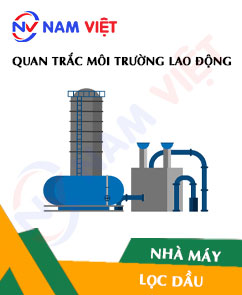
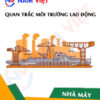
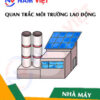
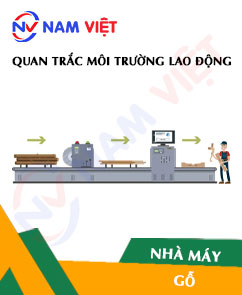




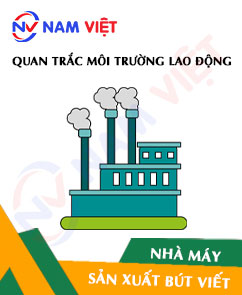


maituyet.cuong12
Professional labor environment monitoring unit